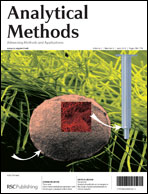The successive projections algorithm (SPA) is a variable selection method that has been compared with the genetic algorithm (GA) due to its ability to solve the descriptor selection problems in QSPR model development. For model development, the popular linear algorithm Partial Least Squares (PLS) was employed to build the model. These methods were used for the prediction of octanol/water partition coefficients Kow of 10 kinds of selected halogen benzoic acids. The root means square error of prediction (RMSEP) for training and prediction sets by GA-PLS and SPA-PLS models were 0.26, 0.28, 0.13 and 0.16, respectively. Also, the relative standard error of prediction (RSEP) for training and prediction sets by GA-PLS and SPA-PLS models were 8.02, 3.92, 8.68 and 4.98 respectively. The resultant data showed that SPA-PLS produced better results than GA-PLS in these class compounds.
You have access to this article
 Please wait while we load your content...
Something went wrong. Try again?
Please wait while we load your content...
Something went wrong. Try again?


 Please wait while we load your content...
Please wait while we load your content...